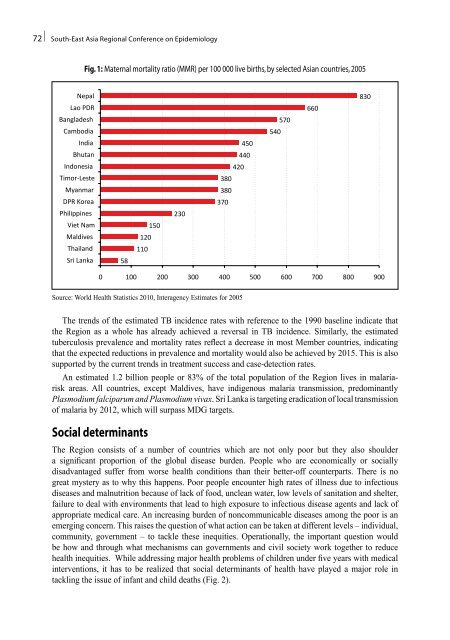South-East Asia Regional Conference on Epidemiology
South-East Asia Regional Conference on Epidemiology
South-East Asia Regional Conference on Epidemiology
Create successful ePaper yourself
Turn your PDF publications into a flip-book with our unique Google optimized e-Paper software.
72 | <str<strong>on</strong>g>South</str<strong>on</strong>g>-<str<strong>on</strong>g>East</str<strong>on</strong>g> <str<strong>on</strong>g>Asia</str<strong>on</strong>g> <str<strong>on</strong>g>Regi<strong>on</strong>al</str<strong>on</strong>g> <str<strong>on</strong>g>C<strong>on</strong>ference</str<strong>on</strong>g> <strong>on</strong> <strong>Epidemiology</strong><br />
Fig. 1: Maternal mortality ratio (MMR) per 100 000 live births, by selected <str<strong>on</strong>g>Asia</str<strong>on</strong>g>n countries, 2005<br />
Source: World Health Statistics 2010, Interagency Estimates for 2005<br />
The trends of the estimated TB incidence rates with reference to the 1990 baseline indicate that<br />
the Regi<strong>on</strong> as a whole has already achieved a reversal in TB incidence. Similarly, the estimated<br />
tuberculosis prevalence and mortality rates reflect a decrease in most Member countries, indicating<br />
that the expected reducti<strong>on</strong>s in prevalence and mortality would also be achieved by 2015. This is also<br />
supported by the current trends in treatment success and case-detecti<strong>on</strong> rates.<br />
An estimated 1.2 billi<strong>on</strong> people or 83% of the total populati<strong>on</strong> of the Regi<strong>on</strong> lives in malariarisk<br />
areas. All countries, except Maldives, have indigenous malaria transmissi<strong>on</strong>, predominantly<br />
Plasmodium falciparum and Plasmodium vivax. Sri Lanka is targeting eradicati<strong>on</strong> of local transmissi<strong>on</strong><br />
of malaria by 2012, which will surpass MDG targets.<br />
Social determinants<br />
The Regi<strong>on</strong> c<strong>on</strong>sists of a number of countries which are not <strong>on</strong>ly poor but they also shoulder<br />
a significant proporti<strong>on</strong> of the global disease burden. People who are ec<strong>on</strong>omically or socially<br />
disadvantaged suffer from worse health c<strong>on</strong>diti<strong>on</strong>s than their better-off counterparts. There is no<br />
great mystery as to why this happens. Poor people encounter high rates of illness due to infectious<br />
diseases and malnutriti<strong>on</strong> because of lack of food, unclean water, low levels of sanitati<strong>on</strong> and shelter,<br />
failure to deal with envir<strong>on</strong>ments that lead to high exposure to infectious disease agents and lack of<br />
appropriate medical care. An increasing burden of n<strong>on</strong>communicable diseases am<strong>on</strong>g the poor is an<br />
emerging c<strong>on</strong>cern. This raises the questi<strong>on</strong> of what acti<strong>on</strong> can be taken at different levels – individual,<br />
community, government – to tackle these inequities. Operati<strong>on</strong>ally, the important questi<strong>on</strong> would<br />
be how and through what mechanisms can governments and civil society work together to reduce<br />
health inequities. While addressing major health problems of children under five years with medical<br />
interventi<strong>on</strong>s, it has to be realized that social determinants of health have played a major role in<br />
tackling the issue of infant and child deaths (Fig. 2).









